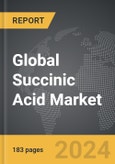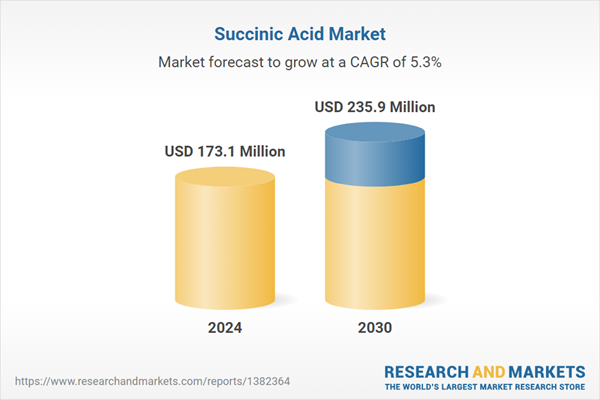The global market for Succinic Acid was valued at US$173.1 Million in 2024 and is projected to reach US$235.9 Million by 2030, growing at a CAGR of 5.3% from 2024 to 2030. This comprehensive report provides an in-depth analysis of market trends, drivers, and forecasts, helping you make informed business decisions. The report includes the most recent global tariff developments and how they impact the Succinic Acid market.
The applications of succinic acid are extensive and diverse, underscoring its industrial significance. In the polymer industry, succinic acid is pivotal in producing biodegradable plastics and polyurethanes, offering eco-friendly alternatives to traditional petrochemical-based plastics. These biodegradable plastics are increasingly important as industries and consumers seek sustainable solutions to reduce environmental pollution. Succinic acid also plays a vital role in manufacturing solvents, lubricants, and coatings, enhancing the performance and sustainability of these products. In agriculture, succinic acid is used in fertilizers and soil conditioners, improving crop yield and soil health by enhancing nutrient availability and promoting beneficial microbial activity. The food and beverage industry leverages succinic acid as an acidity regulator and flavor enhancer, contributing to the taste, texture, and stability of various products. In the pharmaceutical sector, succinic acid is used in drug formulation and dietary supplements, capitalizing on its biochemical properties to enhance efficacy and stability.
The growth in the succinic acid market is driven by several factors. Advancements in fermentation processes have significantly improved the efficiency and yield of bio-based succinic acid production, making it more cost-competitive with traditional petrochemical methods. This shift towards sustainable production is supported by stringent environmental regulations and a growing consumer preference for eco-friendly products. The rising demand for biodegradable plastics and green solvents in various industries, including packaging, automotive, and consumer goods, is a major driver of market expansion. As industries strive to reduce their environmental footprint, the adoption of succinic acid-based solutions is accelerating. Additionally, the expanding agricultural sector, driven by the need to increase food production and improve soil health, is boosting demand for succinic acid-based fertilizers and soil conditioners. The pharmaceutical and food industries also contribute to the market's growth, with ongoing product development and innovation driving the need for high-purity succinic acid. These trends indicate a robust and growing market for succinic acid, supported by continuous innovations and the expanding scope of its applications across various sectors.
Segments: Type (Petro-Based, Bio-Based); End-Use (Industrial, Coatings, Food & Beverages, Cosmetics, Other End-Uses).
Geographic Regions/Countries: World; United States; Canada; Japan; China; Europe (France; Germany; Italy; United Kingdom; Spain; Russia; and Rest of Europe); Asia-Pacific (Australia; India; South Korea; and Rest of Asia-Pacific); Latin America (Argentina; Brazil; Mexico; and Rest of Latin America); Middle East (Iran; Israel; Saudi Arabia; United Arab Emirates; and Rest of Middle East); and Africa.
The analysts continuously track trade developments worldwide, drawing insights from leading global economists and over 200 industry and policy institutions, including think tanks, trade organizations, and national economic advisory bodies. This intelligence is integrated into forecasting models to provide timely, data-driven analysis of emerging risks and opportunities.
Succinic Acid - Key Trends and Drivers
Succinic acid, a dicarboxylic acid with the chemical formula C4H6O4, is a valuable intermediate in the synthesis of numerous chemicals and products. It naturally occurs in living organisms as a key component of the citric acid cycle, crucial for cellular respiration. Industrial production of succinic acid can be achieved through traditional petrochemical processes or more sustainable methods like the fermentation of glucose by microorganisms. The latter method, bio-based production, is gaining traction due to its lower environmental impact and alignment with green chemistry principles. Succinic acid's versatility extends across various industries, serving as a precursor to compounds such as butanediol, tetrahydrofuran, and various polyesters. Additionally, it is used as a food additive, flavoring agent, and pH regulator, showcasing its broad utility in multiple sectors.The applications of succinic acid are extensive and diverse, underscoring its industrial significance. In the polymer industry, succinic acid is pivotal in producing biodegradable plastics and polyurethanes, offering eco-friendly alternatives to traditional petrochemical-based plastics. These biodegradable plastics are increasingly important as industries and consumers seek sustainable solutions to reduce environmental pollution. Succinic acid also plays a vital role in manufacturing solvents, lubricants, and coatings, enhancing the performance and sustainability of these products. In agriculture, succinic acid is used in fertilizers and soil conditioners, improving crop yield and soil health by enhancing nutrient availability and promoting beneficial microbial activity. The food and beverage industry leverages succinic acid as an acidity regulator and flavor enhancer, contributing to the taste, texture, and stability of various products. In the pharmaceutical sector, succinic acid is used in drug formulation and dietary supplements, capitalizing on its biochemical properties to enhance efficacy and stability.
The growth in the succinic acid market is driven by several factors. Advancements in fermentation processes have significantly improved the efficiency and yield of bio-based succinic acid production, making it more cost-competitive with traditional petrochemical methods. This shift towards sustainable production is supported by stringent environmental regulations and a growing consumer preference for eco-friendly products. The rising demand for biodegradable plastics and green solvents in various industries, including packaging, automotive, and consumer goods, is a major driver of market expansion. As industries strive to reduce their environmental footprint, the adoption of succinic acid-based solutions is accelerating. Additionally, the expanding agricultural sector, driven by the need to increase food production and improve soil health, is boosting demand for succinic acid-based fertilizers and soil conditioners. The pharmaceutical and food industries also contribute to the market's growth, with ongoing product development and innovation driving the need for high-purity succinic acid. These trends indicate a robust and growing market for succinic acid, supported by continuous innovations and the expanding scope of its applications across various sectors.
Report Scope
The report analyzes the Succinic Acid market, presented in terms of units. The analysis covers the key segments and geographic regions outlined below.Segments: Type (Petro-Based, Bio-Based); End-Use (Industrial, Coatings, Food & Beverages, Cosmetics, Other End-Uses).
Geographic Regions/Countries: World; United States; Canada; Japan; China; Europe (France; Germany; Italy; United Kingdom; Spain; Russia; and Rest of Europe); Asia-Pacific (Australia; India; South Korea; and Rest of Asia-Pacific); Latin America (Argentina; Brazil; Mexico; and Rest of Latin America); Middle East (Iran; Israel; Saudi Arabia; United Arab Emirates; and Rest of Middle East); and Africa.
Key Insights:
- Market Growth: Understand the significant growth trajectory of the Petro-based segment, which is expected to reach US$152.0 Million by 2030 with a CAGR of a 5.8%. The Bio-based segment is also set to grow at 4.5% CAGR over the analysis period.
- Regional Analysis: Gain insights into the U.S. market, valued at $46.0 Million in 2024, and China, forecasted to grow at an impressive 8.8% CAGR to reach $52.0 Million by 2030. Discover growth trends in other key regions, including Japan, Canada, Germany, and the Asia-Pacific.
Why You Should Buy This Report:
- Detailed Market Analysis: Access a thorough analysis of the Global Succinic Acid Market, covering all major geographic regions and market segments.
- Competitive Insights: Get an overview of the competitive landscape, including the market presence of major players across different geographies.
- Future Trends and Drivers: Understand the key trends and drivers shaping the future of the Global Succinic Acid Market.
- Actionable Insights: Benefit from actionable insights that can help you identify new revenue opportunities and make strategic business decisions.
Key Questions Answered:
- How is the Global Succinic Acid Market expected to evolve by 2030?
- What are the main drivers and restraints affecting the market?
- Which market segments will grow the most over the forecast period?
- How will market shares for different regions and segments change by 2030?
- Who are the leading players in the market, and what are their prospects?
Report Features:
- Comprehensive Market Data: Independent analysis of annual sales and market forecasts in US$ Million from 2024 to 2030.
- In-Depth Regional Analysis: Detailed insights into key markets, including the U.S., China, Japan, Canada, Europe, Asia-Pacific, Latin America, Middle East, and Africa.
- Company Profiles: Coverage of players such as Air Water Performance Chemical Inc., Anqing He Xing Chemical Corporation Ltd., BASF Corporation, BioAmber, Inc., Biosynth AG and more.
- Complimentary Updates: Receive free report updates for one year to keep you informed of the latest market developments.
Some of the 22 companies featured in this Succinic Acid market report include:
- Air Water Performance Chemical Inc.
- Anqing He Xing Chemical Corporation Ltd.
- BASF Corporation
- BioAmber, Inc.
- Biosynth AG
- Chemceed
- Corbion NV
- Fisher Scientific Company, L.L.C.
- Hampton Research
- Kawasaki Kasei Chemicals Ltd.
Tariff Impact Analysis: Key Insights for 2025
Global tariff negotiations across 180+ countries are reshaping supply chains, costs, and competitiveness. This report reflects the latest developments as of April 2025 and incorporates forward-looking insights into the market outlook.The analysts continuously track trade developments worldwide, drawing insights from leading global economists and over 200 industry and policy institutions, including think tanks, trade organizations, and national economic advisory bodies. This intelligence is integrated into forecasting models to provide timely, data-driven analysis of emerging risks and opportunities.
What’s Included in This Edition:
- Tariff-adjusted market forecasts by region and segment
- Analysis of cost and supply chain implications by sourcing and trade exposure
- Strategic insights into geographic shifts
Buyers receive a free July 2025 update with:
- Finalized tariff impacts and new trade agreement effects
- Updated projections reflecting global sourcing and cost shifts
- Expanded country-specific coverage across the industry
Table of Contents
I. METHODOLOGYII. EXECUTIVE SUMMARY2. FOCUS ON SELECT PLAYERSIII. MARKET ANALYSISSOUTH KOREAREST OF ASIA-PACIFICARGENTINABRAZILMEXICOREST OF LATIN AMERICAIRANISRAELSAUDI ARABIAUNITED ARAB EMIRATESREST OF MIDDLE EASTIV. COMPETITION
1. MARKET OVERVIEW
3. MARKET TRENDS & DRIVERS
4. GLOBAL MARKET PERSPECTIVE
UNITED STATES
CANADA
JAPAN
CHINA
EUROPE
FRANCE
GERMANY
ITALY
UNITED KINGDOM
SPAIN
RUSSIA
REST OF EUROPE
ASIA-PACIFIC
AUSTRALIA
INDIA
LATIN AMERICA
MIDDLE EAST
AFRICA
Companies Mentioned (Partial List)
A selection of companies mentioned in this report includes, but is not limited to:
- Air Water Performance Chemical Inc.
- Anqing He Xing Chemical Corporation Ltd.
- BASF Corporation
- BioAmber, Inc.
- Biosynth AG
- Chemceed
- Corbion NV
- Fisher Scientific Company, L.L.C.
- Hampton Research
- Kawasaki Kasei Chemicals Ltd.
Table Information
| Report Attribute | Details |
|---|---|
| No. of Pages | 183 |
| Published | April 2025 |
| Forecast Period | 2024 - 2030 |
| Estimated Market Value ( USD | $ 173.1 Million |
| Forecasted Market Value ( USD | $ 235.9 Million |
| Compound Annual Growth Rate | 5.3% |
| Regions Covered | Global |









